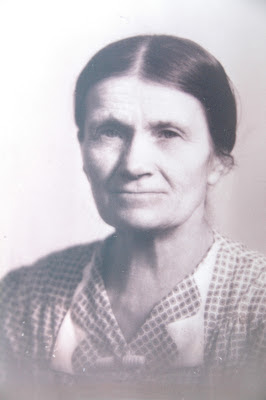PHOTO OF THE WEEK
This photo of the week features my great-great grandmother, Katherine (Catherina or Kata) Turenchalk (b. abt 1877, d. October 11, 1941). Katherine was my grandmother Mary Oschip's maternal grandmother. Katherine was likely born in the area of modern-day Jablonki, Podkarpackie, Poland. Unfortunately most Greek Catholic records in Jablonki were lost during World War II and the cemetery is mostly in ruins, so it has been tough to find more information than what my research has already taught me. However, I have been in contact with someone who was born and raised in Jablonki and will be helping me with more research in the future. I have found several possible maiden names for Katherine. They include Elko, Drahuszczak and Wolana---I am still researching all these possibilities---none are from a direct source. If anyone has a better idea, please let me know! (As I will share in a later blog post, Rusyn naming habits sometimes left people "changing" their surname to become more identifiable amongst other family members with the same name!)
Katherine and Piza joined Harry Turenchalk and settled in Indiana County, Pennsylvania where she remained until after Harry's death. In the early-to-mid 1920s Katherine and some of her children moved to Yonkers, New York.
On a side note: If you are a MALE descendant of Harry Turenchalk WITH the Turenchalk last name---a possible mutual cousin would be interested in doing an Ancestry DNA test to confirm the connection between Hryc Turenchalk and a man named Wasyl Turenchalk to see if they were brothers. Contact me and I will connect you with the possible cousin. The testing is safe and results are as private as you want them to be. Thanks!
This photo of the week features my great-great grandmother, Katherine (Catherina or Kata) Turenchalk (b. abt 1877, d. October 11, 1941). Katherine was my grandmother Mary Oschip's maternal grandmother. Katherine was likely born in the area of modern-day Jablonki, Podkarpackie, Poland. Unfortunately most Greek Catholic records in Jablonki were lost during World War II and the cemetery is mostly in ruins, so it has been tough to find more information than what my research has already taught me. However, I have been in contact with someone who was born and raised in Jablonki and will be helping me with more research in the future. I have found several possible maiden names for Katherine. They include Elko, Drahuszczak and Wolana---I am still researching all these possibilities---none are from a direct source. If anyone has a better idea, please let me know! (As I will share in a later blog post, Rusyn naming habits sometimes left people "changing" their surname to become more identifiable amongst other family members with the same name!)
 |
| Katherine Turenchalk (abt 1877-October 11, 1941) (Thank you to my cousin Cheryl for recently sharing this photo with me!) |
Katherine arrived in the United States on November 17, 1907 with my great-grandmother Piza, who was three at the time. They arrived via Ellis Island and made their way to her husband Hryc (Gregor or Harry) who had already arrived in the United States. Family "lore" says that Piza and Katherine were sick when they came to Ellis Island and Piza was hidden in Katherine skirts so that it concealed just how sick Piza was at the time. I have included the "passenger record" and a copy of the original manifest from Ellis Island that shows Katherine's entry to the United States. The manifest does actually mark both Katherine and Piza as being sick, but then later admitted.
 |
| Certificate information of Katherina's entry to the United States from Ellis Island. Record can be found at ellisisland.org or follow this link directly: Kata Turynczak Passenger Record. |
 |
| The original manifest of Katherina and Pisa Turenchalk. This record can be found at ellisisland.org or follow this link directly: Kata Turynczak Ship Manifest. Both "Kata" and "Pazia" were marked as sick first and then admitted. |
 |
| From left to right: George, John, Katherine, Katherine Turenchalk (mother), Mary and Harry Jr. (Thank you to my cousin Cassie for sharing this photo with me) |
On a side note: If you are a MALE descendant of Harry Turenchalk WITH the Turenchalk last name---a possible mutual cousin would be interested in doing an Ancestry DNA test to confirm the connection between Hryc Turenchalk and a man named Wasyl Turenchalk to see if they were brothers. Contact me and I will connect you with the possible cousin. The testing is safe and results are as private as you want them to be. Thanks!

